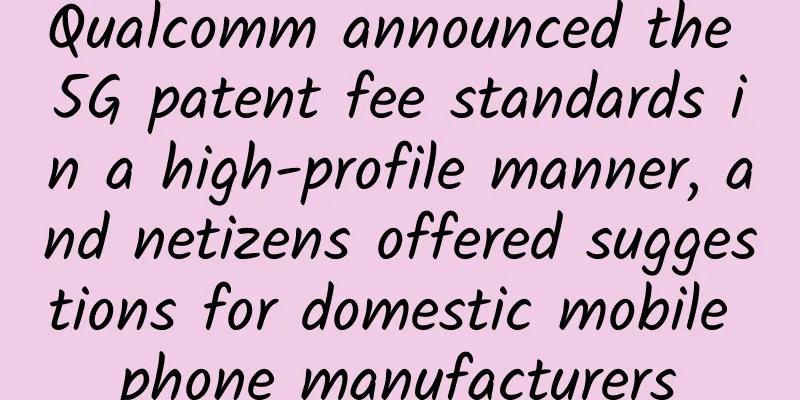Qualcomm announced the 5G patent fee standards in a high-profile manner, and netizens offered suggestions for domestic mobile phone manufacturers

|
5G will not be commercially available until next year at the earliest, and Qualcomm announced its 5G patent charging plan last month:
According to this standard, domestic mobile phone manufacturers have to pay Qualcomm 97.5 to 150 yuan for every mobile phone priced at 3,000 yuan sold.
Qualcomm's 5G mobile phone chips will be mass-produced in 2018 As soon as such an aggressive unilateral charging plan was announced, domestic netizens went wild. Some concerned citizens began to analyze the problem for domestic mobile phone manufacturers and proposed solutions. An article titled "5G mobile phone patents may be monopolized by Qualcomm again? Domestic mobile phones may only rely on Huawei" was reprinted by major media, and the original source is unknown. The author pointed out that "the only way to escape Qualcomm's clutches is to produce chips by ourselves." However, Qualcomm does not produce its own chips, but TSMC does. Similarly, Huawei and Apple must have their chips manufactured by foundries, so they can't be considered to be able to produce chips themselves, right? In fact, the author of this article completely misunderstood the "patent licensing fee". According to his logic, only chip manufacturers such as Samsung, TSMC, and MediaTek can avoid paying licensing fees. However, Samsung and Apple are currently suing Qualcomm and are thinking about not paying patent fees in the future! In other words, up to now, they still have to pay "tolls" to Qualcomm. From the perspective of intellectual property protection, as long as you use someone else's patent, you must pay fees. Even if TSMC wants to sell the extra chips privately, it still has to pay patent fees to the patent owner. Samsung, Huawei, and Apple dared to come out and overthrow Qualcomm because they also have some patents. However, even if Samsung and Huawei have a large number of patents, it does not mean that they do not have to pay patent fees to others. Instead, they are just cross-licensing, exchanging their own patents for the right to use other people's patents. The lawsuit is nothing more than everyone counting how many patents each has, how much each patent is worth, and whether there are enough to exchange, that's all! It seems simple, but it is very difficult for Samsung, Huawei and Apple to defeat Qualcomm. We speak with data! Since we can’t find the latest data on the Internet, we will use older data to illustrate the problem. On March 9, 2016, the North American Intellectual Property Journal published an article titled "How can Taiwan refuse to be marginalized as the 5G standard essential patent war begins?" which listed some data that gave me a rough idea of Qualcomm's strength. Distribution of 5G patent holders by country From the above figure, we can see that the United States has an absolute monopoly in 5G technology patents, owning 41% of 5G patents, followed by South Korea with 14% and Japan with 9%. Mainland China ranks only sixth, less than half of Japan. 5G Patent Owners Among the companies that own 5G patents, Qualcomm and Ericsson are similar, ranking first and second, while Huawei has only one-third of Qualcomm's patents, ranking tenth, far less than Samsung. Apple is nowhere to be found, so if Apple wants to win the lawsuit against Qualcomm, it can only use other patents to make up for it. However, Qualcomm does not produce mobile phones itself, so Qualcomm cannot use Apple's patents on mobile phones. It seems that it is more likely to be defeated by Qualcomm. Huawei, which is in a difficult situation, must pay a "toll" to Qualcomm if it wants to sell its Kirin chips to other domestic manufacturers even if the chip production is sufficient. On December 3, the day before yesterday, Huawei's rotating CEO Xu Zhijun said:
|
>>: Android Go is here, and the world's "feature phones" will become history
Recommend
Android Wear 2.0 preview: new single sign-on feature
In the recently released Android Wear 2.0 develop...
White UI design is not the only minimalist design
Since the products of several Internet companies ...
Increase the conversion rate of bidding accounts by 20%?
Whether it is a search account or an information ...
Umbrella Google: The birth of a technology empire that will last for generations
[[144870]] Recently, Google announced that it wil...
How do you write copy that will inspire users to place orders after reading it?
Copywriting with sufficient promotional power wil...
Less than a year after its launch, how is NetEase Wugu Reading operating?
Who is NetEase Wugu Reading ? An app for reading ...
Yuke Alliance · Xianyu no-source operation plan, e-commerce operation tips that you can get started with after listening to it
Yuke Alliance · Xianyu no-source operation plan, ...
Digital RMB is so popular! Alipay can’t hold back
[[395030]] With the popularity of digital RMB har...
The war between the two giants of mobile payment: Will NFC be the next protagonist?
July 10 news, how long have you not gone to an AT...
Get APP competitive product analysis
The overall feeling that Get gives me is that it ...
Let me give you an example of the pitfalls I encountered when making event products (data review)
Let’s review the activity process first: 1. Total...
In-depth analysis of activity operations: post-launch operation plan
First look at this picture: I divided the operati...
How many mini-programs can one person register? Who can apply for WeChat Mini Program?
Q: How many mini programs can one person register...
Analyzing the hot-selling machine - the community ecology of Toutiao
As one of ByteDance's popular apps, Toutiao i...
Node.js 4.0.0 is here, ECMAScript 6 is back
The latest upgraded version of server-side JavaSc...









